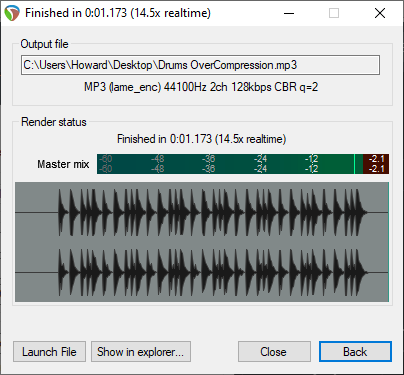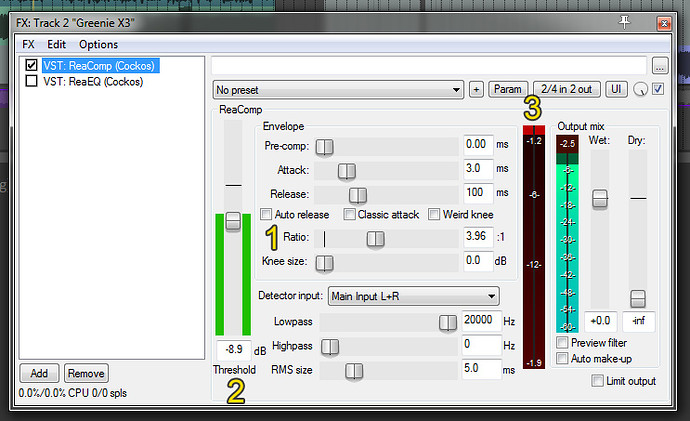yeah I could see owning two, one clean and one dirty. my vmt is always on to just thicken things up while still being clean.
I don’t even have a clean tone. even with my dark country things, I always keep a little bit of clipping, just to add a little bit of dirty grain.
@chris6 that HOF is a nice reverb pedal, I actually had one for a short time but sold it and bought a Flamma FS02 which I really like. There actually are some situations where a reverb can be used in a performance.
Like most of the time 
Reverb is more or less a required effect IMO. Maybe a bit less for bass than guitars and vocals, but still super useful with bass.
For those of you (like me) eternally struggling to grasp what a compressor actually does (not just in theory) and just generally wondering about sound a lot, the first three and a half minutes of this video are quite enlightening:
The big breakthrough is realizing that compressors and limiters are used to make the good tone louder.
He also just made me want Helix Native again.
Yeah that was educational. I guess I always thought of compressors as limiting the peaks, but it’s also about raising the valleys. I have a Keeley Bassist next on my list.
It’s funny because I just sent this to a friend as an extreme example of compression. What I do with levels and the limiter here is exactly equivalent to compression with a long release time. This is obviously an extreme example, not a desirable outcome 
Ok. Here’s some drums with a nice, normal amount of reverb and compression.
Those sound great. Nice dynamic range. You can see the transients here vastly dominating the sound:

Now, in this one, same drum track, but I ran the drums way up in to the limiter, compressing the hell out of them:
See how that sounds different? Like it is much louder, but squishy?
It’s a sonic illusion - actually those two tracks are exactly the same peak levels, but the dynamic range is less and the nontransient parts of the drum sound are louder:

Both hit a peak level of -2.1db, but the second one sounds much louder. And less dynamic.
The compression really amplifies the reverb there too.
And then there is also this - that was actually super educational (for me) as well:
I am starting to really like his stuff… and his style (hope he stays away from annoying, overused, and just too many flashy effects that some other YT’ers seem to gravitate towards).
Paul Davids? Yeah he’s awesome, love his guitar youtube content. He’s basically the Adam Neely or Nahre Sol of Guitar.
I like Paul Davids too. Great guitar player and he lives in the same town where I live! Well according to Bandcamp 
Very interesting compressor video. Thanks for posting it @joergkutter
My question: would it be better to record using the compressor on my board, or the compressor in the DAW (Reaper)? Or does it even make any difference?
As long as you can reproroduce your settings it doesn’t really matter much.
Personally, I do everything in the DAW now because I find it to be the most flexible. I only record clean bass in these days, and apply all effects, including compression, in the DAW. That way I never need to remember what the pedals were set to if I need to rerecord something.
But if you have a compressor pedal (or other effects) that you like, it’s fine to use them too. Just remember what they were set to so you can go back to it later if needed.
a compressor before (often a pedal) or after (often a software/VST) the preamp does not behave the same at all. the more the preamp modifies the signal from the bass, the more it’s true.
One thing that is true though - the software compressors are often far, far more capable than any pedal you will be able to reasonably buy.
This is definitely true if using a preamp before the DAI.
Okay @howard another techie question for you:
I’ve gotten to where I’ve been using the compressor in Reaper instead of the one on my board, but am clueless about the settings, so I’ve just been using the preset “spanky bass” (only because I like the name). However, I feel lame not knowing what all those sliders are for. Is there a tutorial anywhere that you know of (Kenny perhaps?) that explains it?
Also, do you or @terb have any favorite settings? Thanks!
a good starting point with ReaComp (the simple compressor in Reaper) in my opinion : keep all the sliders in the default position except :
- set the “ratio” (1) to around 4
- set the “threshold” (2) in a way that when you play your track, the vertical bar on the right (3) shows a little bit of bright red with a low signal drop
then you adjust the compression level by ear with the “threshold” slider.
also you can check the “Auto make-up” box (bottom right) if you want, it’s not mandatory but it will help to bring a consistant output level.
I actually don’t use Reaper’s compressor; I use several other plugins.
however, most compressors have variations on the following controls:
Attack - how long a sound has to play before a compressor kicks in. For faster transients (drums, pick, slap) you want a faster attack; for (say) fingerstyle bass, slower.
Release - How long the compression remains active after it is triggered. For increase this time for smoother sounds, at the expense of compressing when it might not be needed/desired.
Threshold - what dB level the compressor kicks in at. The lower the threshold, the more dynamic range of sound gets compressed.
Ratio - the compression ratio. The lower the ratio, the less the signal is attenuated during compression. Limiters are basically infinite ratio compressors.
Makeup Volume - the amount of volume increase to apply, based on the compression ratio, to the resulting unattenuated part of the signal after compression.
edit: @terb slipped in with good info about ReaComp 


